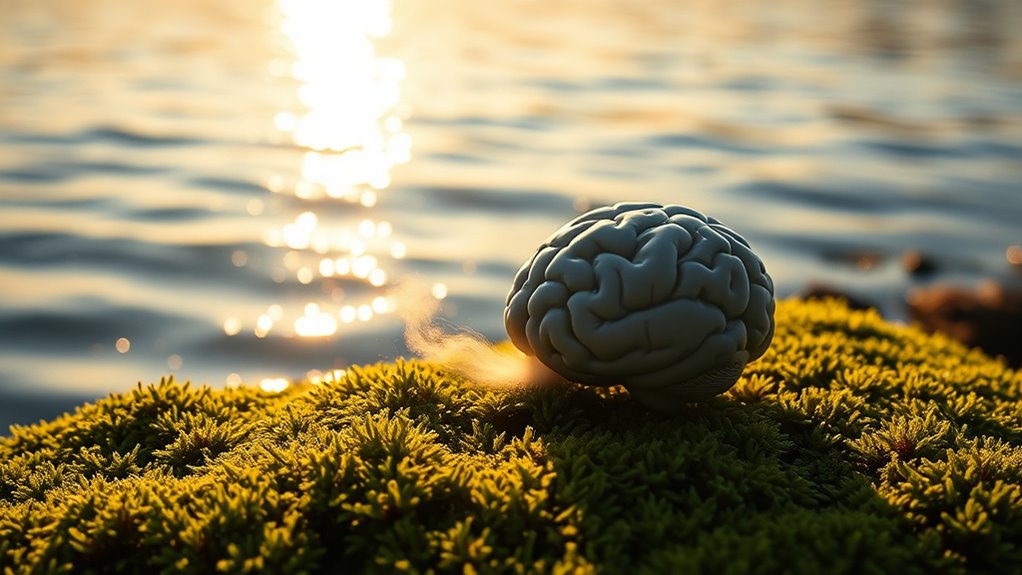Microplastics are tiny plastic particles that can affect your brain health more than you think. They seep into your food and water, carrying harmful pollutants that may disrupt brain function. The stress of knowing about these hidden threats can lead to anxiety and even feelings of hopelessness. Living in a polluted environment adds to this mental burden. Understanding these issues is essential for protecting your well-being, and there’s much more to explore on how to combat these threats.
Key Takeaways
- Microplastics can act as neurotoxins, potentially impairing brain function and impacting mental health through ingestion and environmental exposure.
- Awareness of microplastic contamination can induce stress and anxiety, negatively affecting daily focus and overall well-being.
- Living in polluted environments increases feelings of helplessness and frustration, contributing to anxiety, depression, and hopelessness.
- Societal polarization over environmental issues may exacerbate feelings of isolation and mental health challenges within communities.
- Taking action to reduce microplastic exposure and advocating for environmental change can help protect mental well-being and promote healthier communities.

Have you ever wondered how the tiny particles we find in our environment might affect our minds? Microplastics, those minuscule fragments resulting from the breakdown of larger plastic items, have infiltrated our air, water, and food. While you might be focused on the physical health implications of microplastic ingestion, it’s essential to contemplate the psychological impacts of pollutants like these on your mental well-being. The link between environmental factors and mental health is becoming increasingly clear, and understanding this connection could empower you to make more informed choices.
When you ingest microplastics, you’re not just consuming physical substances; you’re also introducing potential neurotoxins into your system. Research suggests that these particles can carry harmful chemicals and pollutants into your body, which may interfere with your brain function. Imagine the stress and anxiety that could arise from knowing that each meal could contain these hidden threats. The constant worry about contamination can create an underlying sense of unease, making it harder for you to focus on daily tasks.
Ingesting microplastics introduces potential neurotoxins, heightening stress and anxiety about hidden threats in our food.
Additionally, the psychological impacts of pollutants extend beyond just ingestion. Living in an environment laden with microplastics can heighten feelings of helplessness and frustration. You might find yourself grappling with the knowledge that these pollutants are pervasive and difficult to avoid. This awareness can contribute to an overall decline in mental health, manifesting as anxiety, depression, or even a sense of hopelessness about the future of our planet. It’s a heavy burden to carry, knowing that microplastics are not just affecting your body but also your mind.
Furthermore, the societal implications can’t be ignored. As awareness of microplastic pollution grows, communities can become polarized over environmental issues. This division can lead to increased tension and conflict, further impacting your psychological well-being. The stress of managing these conversations can leave you feeling isolated or frustrated, reinforcing the mental health challenges already posed by the presence of these pollutants. The role of environmental factors in shaping mental health highlights the urgent need for awareness and action against pollution.
Frequently Asked Questions
What Are Microplastics Made Of?
Microplastics are primarily made of plastic polymers, which are long chains of molecules derived from petroleum products. These tiny particles often come from the breakdown of larger plastic items, like bottles and bags. Additionally, synthetic fibers shed from clothing during washing contribute to microplastic pollution. When you wash your clothes, those fibers can end up in waterways, further increasing the prevalence of microplastics in the environment and potentially impacting your health.
How Do Microplastics Enter the Human Body?
Did you know that the average person might ingest over 100 tiny pieces of microplastics each week? Microplastics enter your body primarily through ingestion. You consume them when eating contaminated seafood, drinking bottled water, or even inhaling air filled with pollutants. Environmental contamination is rampant, as these tiny particles break down from larger plastics. Once inside, they can potentially affect your health in various ways, highlighting the importance of awareness and action.
Can Microplastics Affect Physical Health Too?
Yes, microplastics can definitely affect your physical health. These tiny particles can enter your body through food, water, and even the air you breathe, contributing to various health issues. The environmental impact of microplastic pollution extends beyond ecosystems; it poses risks to human health, potentially leading to inflammation or other harmful effects. By being aware of your surroundings and reducing plastic use, you can help mitigate these risks and protect your well-being.
Are There Specific Foods High in Microplastics?
Seafood’s often seen as a significant source of microplastics, especially when you’re consuming shellfish like mussels and oysters. These creatures can accumulate these tiny particles from their environment. Additionally, processed foods and beverages stored in plastic packaging might also contain microplastics. So, if you’re mindful of your dietary sources, you might want to limit your seafood consumption and choose fresh, whole foods to minimize exposure. Stay safe and savvy!
How Can I Reduce My Exposure to Microplastics?
To reduce your exposure to microplastics, start by using microplastic filtration systems in your home, especially for water. Opt for natural fibers in your clothing and bedding, as they shed fewer microplastics. When cleaning your household, use a vacuum with a HEPA filter and regularly dust surfaces to minimize accumulation. Additionally, limit your consumption of processed foods, as they often contain microplastics from packaging. Staying informed and proactive can considerably lower your exposure.
Conclusion
As you navigate the murky waters of modern life, don’t let microplastics cloud your mental clarity. By staying informed and making mindful choices, you can build a fortress around your brain, shielding it from hidden threats. Remember, your mind is a garden; nurture it with clean, pure thoughts and habits. As you sow these seeds of awareness, you’ll cultivate a vibrant landscape of mental well-being, flourishing under the sun of knowledge and protection.










